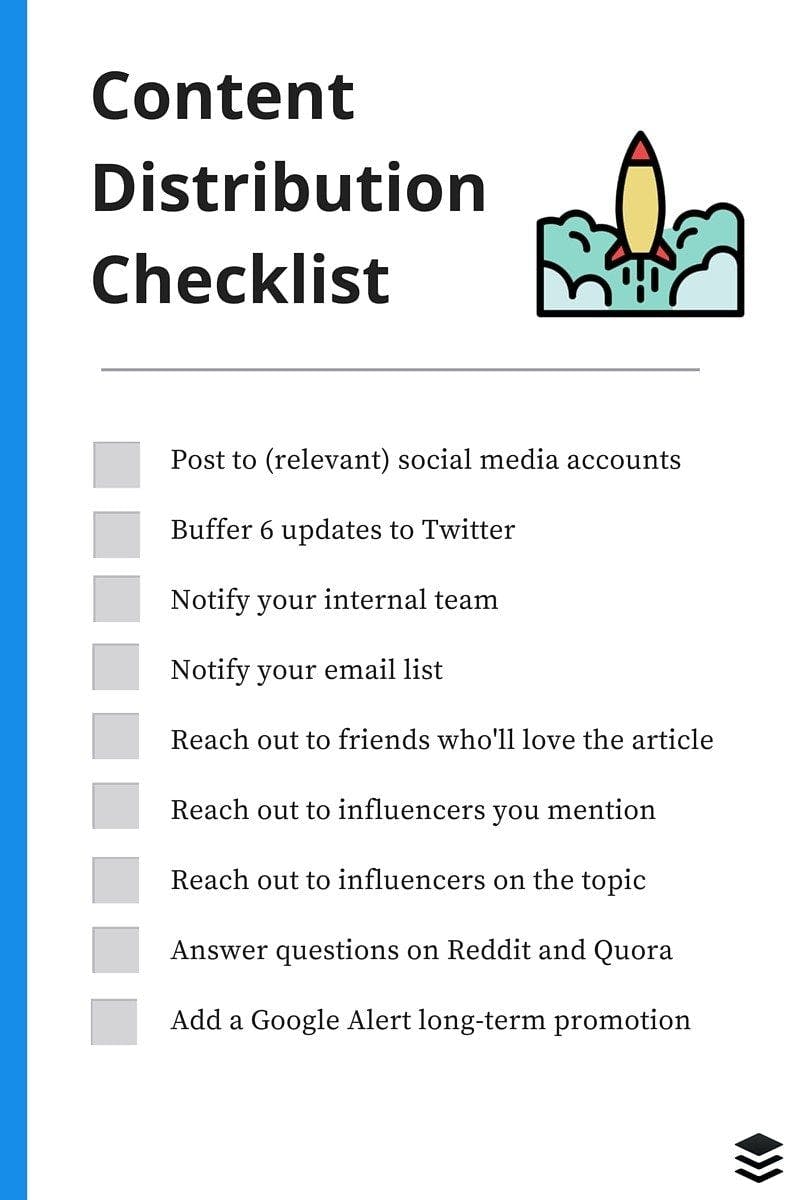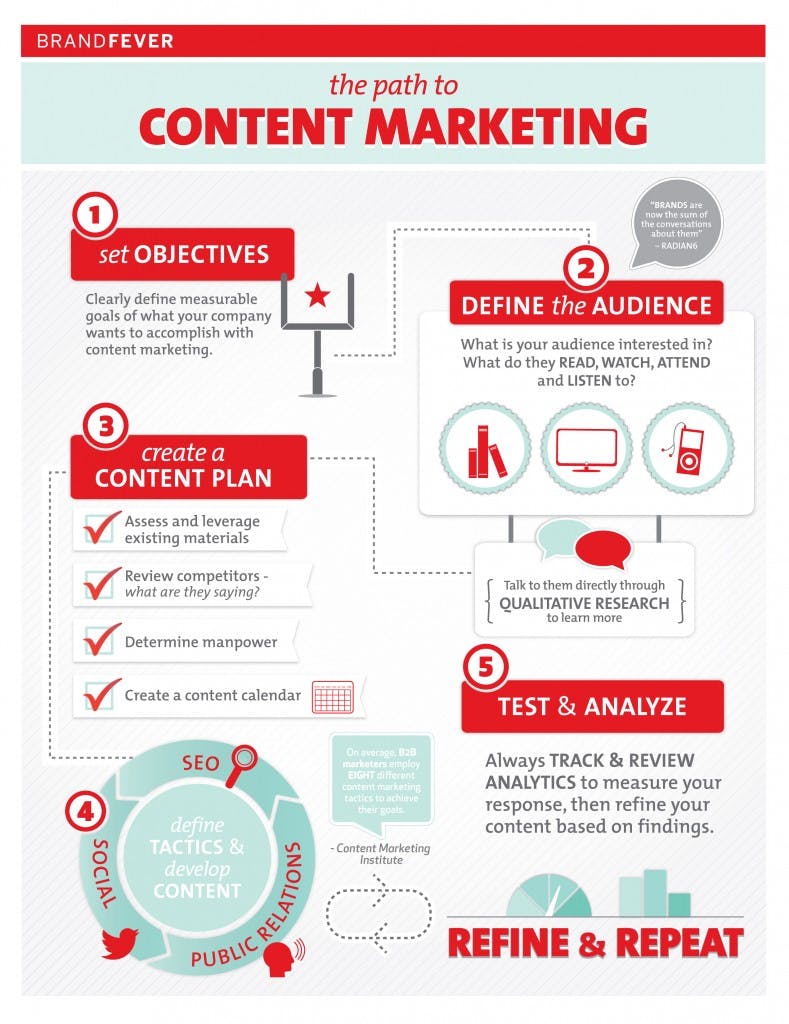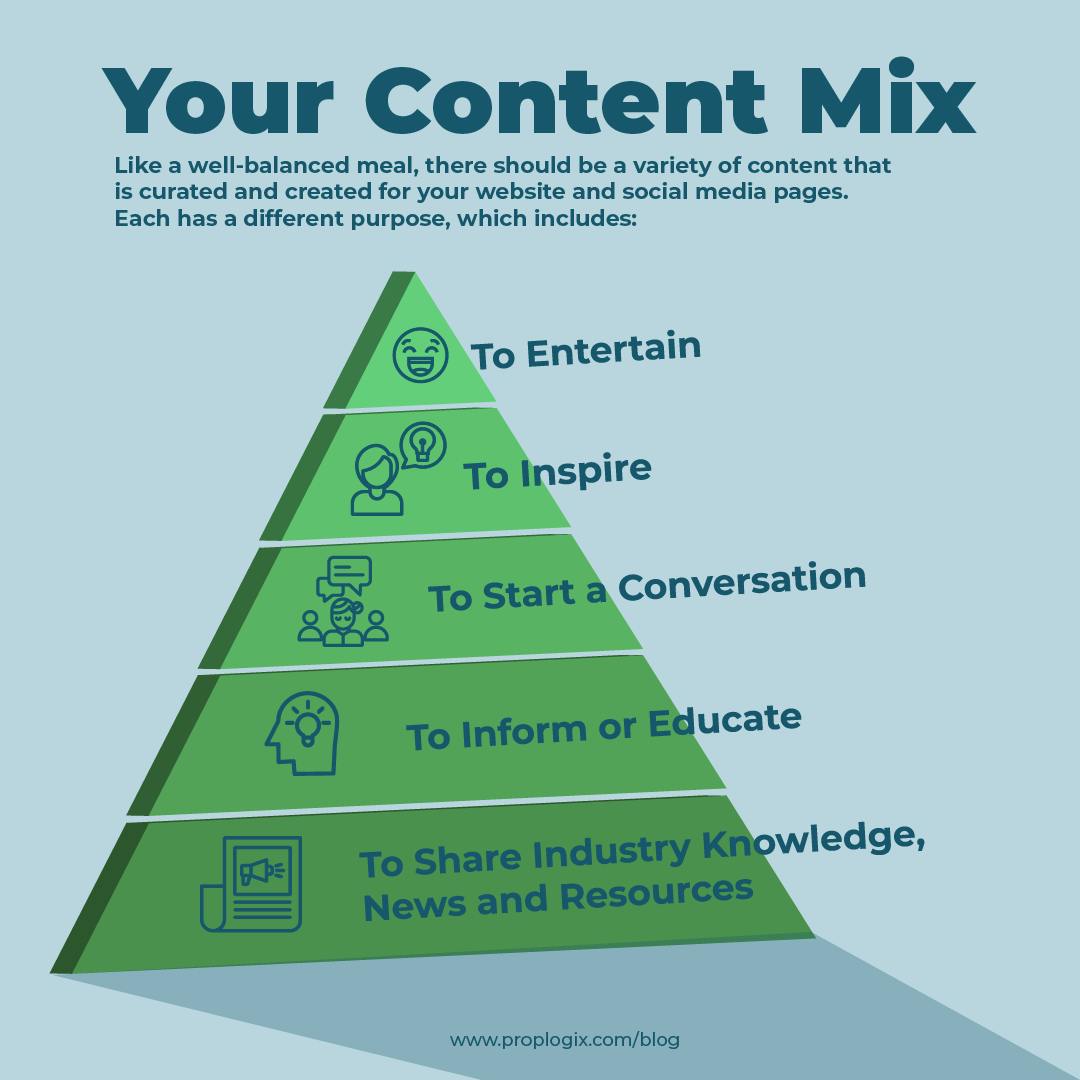13 types of content marketing and how to select the right ones
Apr 5th, 2023

Contents
What is content marketing?
Types of content marketing
How to select the right content marketing mix?
Annual research by Content Marketing Institute demonstrates that the majority of marketers use content marketing. It is employed by many well-known companies around the globe, such as Microsoft and Cisco Systems. Furthermore, small businesses and individual entrepreneurs also use this strategy to attract customers, draw attention to the products and help consumers solve their problems. The reason for this is simple. It works.
Content marketing has several main benefits: higher visibility in search engines, increased conversion potential, improved brand reputation, and reduced marketing costs. In addition, while consumers are overwhelmed with informational garbage and advertisements, content marketing educates customers and provides them with answers to their questions. In this article, we will consider the definition of content marketing, take a closer look at the forms of content marketing and give tips on selecting the right marketing mix for your brand.
What is content marketing?
Content marketing is a strategy aimed at producing and distributing valuable, detailed, and interesting content to draw in and hold the attention of a target audience and encourage customers to take action. Content marketing seeks to help build a long-term relationship with the audience by providing them with high-quality content. It is based on the idea that once customers view a brand as an authority, they will opt for its products and services when making a purchase.
Businesses use content marketing to educate prospects and leads about the brand’s products and services, increase conversion and customer loyalty, demonstrate how a product can solve customer problems, and create a community around the brand. The key to successful content marketing is to provide value. The content is appropriate for a content marketing campaign if consumers actively seek it out and find value in reading the publications. Thus, content marketing is the marketing of attraction.
Content serves as a factual and emotional link between businesses and consumers. Building this connection takes more than a budget, editorial schedule and vision. Content marketing aims not only to generate revenue but also to improve people’s quality of life. By using purposeful content, this strategy seeks to connect customer requirements with business objectives.
Moreover, you cannot rank higher in search results without content marketing. So, if you want to improve your SEO performance, you need to create engaging, high-quality, and in-depth content related to your field of expertise, brand, and message you want to convey.
Types of content marketing
To reach the business objectives and promote your brand effectively, you need to use various types of content in your marketing campaigns. The Internet is a constantly changing environment, so customers can get tired of seeing only one type of content. Therefore, your brand will benefit from investing in diverse content. Moreover, you can adapt each content format to the information you want to convey and the needs of your target audience. So let us consider the most effective types of content marketing.
Blog posts
Blogging has been a key component of content marketing since 1994, when Justin Hall launched the first blog. A blog on your website that is relevant to your product and its target market can attract potential clients looking for the solution your company provides. The success of this low-cost method of brand promotion depends solely on the quality of the content you produce.
Blog articles are a great way to increase organic traffic and improve SEO. Also, they raise customer engagement and boost brand awareness. The average length of a blog post is between 1,500 and 2,500 words, so this content format gives Google’s search bots a wealth of information and helps the search engine determine how to handle the queries. In addition, long-form content tends to be the more evergreen type of content marketing in contrast to other formats. As a result, the materials you publish now can still generate traffic and qualified leads in the future.
To ensure your blog posts generate the maximum amount of traffic and achieve the desired results, you need to make your content SEO-friendly, write posts targeted at readers instead of search engines, link to authoritative websites, and provide product-relevant information. Remember to use long-tail keywords as well. Finally, keep in mind that a blog article will be more likely to draw the desired audience if it is more detailed.
For example, the e-commerce platform Shopify is one of the leading resources online sellers use to improve their skills in running an online business. Although Shopify’s blog used to be primarily targeted at its users, it later became a helpful resource for anyone from small business owners to startup creators. The two main factors that influenced Shopify's blog success were personal stories by other entrepreneurs and practical advice on running an online business.
Video content
Videos are a perfect method to engage your audience. The study by HubSpot demonstrates that 54% of consumers prefer to watch videos from companies they support. Furthermore, users choose videos over other content formats. Therefore, brands use various types of video content for cross-platform customer engagement. This content includes Youtube videos, social media stories, customer interviews, etc.
Although this type of content takes more resources to produce compared to publications or static content, it helps generate more online leads and improve customer understanding of your product or service. Today, if your business can develop quality video content, it will have a higher chance of converting and nurturing a lead than simply investing in written material.
The core strength of video content is its versatility. For example, you can host webinars to demonstrate brand expertise, use social media stories to provide a behind-the-scenes look at your company, and conduct interviews to showcase customer success stories. Besides, product demos, explainers, and how-to videos will help consumers understand the product’s features and advantages.
Cisco has made significant investments in video marketing, resulting in more than 3,000 videos and a production rate of 1,000 videos annually. So even if there are just a few B2B companies with Cisco-level resources, companies may take inspiration from their strategy of employing video marketing to build a priceless library of sales funnel-focused, problem-solving content.
Case studies
Case studies and success stories are highly effective for generating leads at the bottom of the conversion funnel. When prospects read about similar positive experiences with your business, it makes their decision-making process more straightforward and presents you as an expert in your field. The audience sees an actual scenario where people like them use the product to solve their problems. Therefore, they can better understand how your product or service works by observing the entire buying process from beginning to end.
Case studies provide testimonials from your actual consumers to strengthen brand trust and describe real situations that illustrate brand value. According to research by ThinkImpact, 83% of consumers are willing to recommend a business after a successful purchase. This implies that all you have to do to compile a library of case studies is ask your customers for participation.
To create a great case study, choose a topic that will appeal to your target audience, include a cohesive narrative from beginning to end, incorporate accurate statistics, describe how your company solved an issue, and add quotes and testimonials from your customers.
This LinkedIn case study offers a thorough examination of how Adobe uses LinkedIn to promote the brand and attract hard-to-reach marketers. It describes Adobe's marketing with data and screenshots and shows how the company evaluated its effectiveness with the workplace platform. This case study might show other organizations how making similar use of LinkedIn could help them reach the desired audience.
Infographics
Infographics are a visual representation of information on a particular topic. This format is suitable for presenting complex issues and broad subjects in an understandable and digestible format. With infographics, you can demonstrate statistics for your sector or business, maps, and timelines. You can use infographics as a stand-alone content piece or include them in your white papers, blog posts, or social media publications. What is more, this is an incredibly shareable format. Infographics are shared three times more often than other social media content.
This format allows you to highlight important information and attract the attention of people who only scan the text on your website. In addition, when placing the infographics on your website, you can include an HTML code that enables other website owners to embed them on their sites. As a result, whenever someone embeds the infographics, a backlink to your page is automatically added to the description. The more times the infographic is shared, the more backlinks you receive, which improves your SEO performance.

In this infographic, Captora describes the KPIs and tracking tools that marketers find most helpful for monitoring the outcomes of their content marketing strategy. The block structure and the balance between text, photos, and illustrations make it simple for visitors to navigate through the information.
Ebooks
Creating an ebook is of the best methods to position your brand as an authority. Plus, this lengthy format provides value to potential customers instead of serving as an advertisement. The other advantage of creating an ebook is the opportunity to gather customers’ contact information. To download an ebook, customers typically provide their names and email addresses which digital marketers can further use in the nurturing process.
Ebooks are worth the investment as they can significantly increase interest in products and services offered by your business. In addition, this type of content marketing performs well at the middle or the bottom of the sales funnel. During these stages, you should continue educating potential customers about the issue they're experiencing, the solution you provide, and why you're a better option than a rival. By delving deeply into a topic unique to your industry, you can both demonstrate your expertise and inform your audience.
A free eBook by Optimizely called The Experience Optimization Playbook examines optimization tactics used by Fortune 500 companies. With this ebook, readers can discover how to convert more visitors, find worksheets, statistics, and optimization techniques used by Google, HubSpot, Upworthy, and other well-known organizations.
White papers
Both white papers and ebooks are forms of lengthy content, but the latter typically contain more data and statistics. White papers can include the results of your research or information gathered from other sources. This allows you to go into greater detail about a certain topic and share more specific information than you would generally be able to do in blog articles.
This type of content marketing is an excellent tool for developing thought leadership, establishing credibility in your field, generating leads, and proving your expertise. You can create white papers when you have in-depth knowledge or a unique perspective on a particular topic. If you want people to take the time to download your white papers, you need to provide them with high-quality information that lives up to their expectations.
This Siemens white paper attempts to help food and beverage manufacturers increase production to fill various market gaps. It also demonstrates how companies leverage digital technology to streamline their business operations to satisfy the new standards and create customer-specific products.
User-generated content
User-generated content is one of the few content marketing strategies that vastly increase engagement. Prospects are likelier to trust other people’s opinions than information in advertisements. Moreover, when people recommend your product to their friends and family, it increases your brand reach and attracts potential customers.
This type of content marketing is created by your audience and takes the form of social media publications, reviews, recommendations, or influencer content. For example, user-generated content may involve someone using your product in a selfie or mentioning your company in a post. Also, a customer can record a YouTube video of a product unboxing process or share a photo in response to a contest organized by your company. By producing branded content and promoting your existing publications on their pages, your staff members can also turn into brand ambassadors.
You can encourage your customers to produce content by regularly publishing USG on your social media, collaborating with influencers, creating your branded hashtag, and inviting customers to share their content by offering rewards for the best publications and videos.
GoPro, a manufacturer of video equipment, relies on user-generated content to promote its YouTube channel, with its top three videos all made by users. The combined views of those videos reached over 400 million views.
Checklists
Checklists are step-by-step guides to completing a task or resolving an issue. Checklists can help solve even the most complex problems by breaking them into smaller, more manageable ones. They're also a fantastic approach to providing value to customers and generating leads. People like checklists as this form of content ensures that all the necessary steps to achieve the goal are taken. This type of content marketing also helps customers set priorities and establish realistic expectations.
Checklists not only serve as a valuable tool for your customers, but they also show your clients that you are aware of their problems. A good checklist typically contains a heading outlining the list's objectives and value, tasks that define the entire procedure in detail, timelines for every stage, which can be a specific date or range, and status that indicates whether a specific action is completed, in progress, or not started.

The final checkbox in this example from HubSpot Academy demonstrates how marketing is combined with content.
Customer reviews and testimonials
According to research, 93% of consumers claim online reviews would influence their shopping choices, demonstrating that the majority of consumers consistently read customer reviews before making a decision. Testimonials and customer reviews are videos and publications produced directly by your audience, similar to user-generated content. This format concisely summarizes how your business differs from the competition if you are in a niche market.
Reviews and testimonials give you a level of credibility that no paid advertising will ever provide. They are a useful method to overcome customer objections, and since they are generated by customers, they are free for you. You can encourage customers to leave reviews and testimonials by directly asking them to participate in this activity, offering discounts or rewards for reviews, or developing automated responses that make reviewing products easier.
In addition, positive reviews can affect your SEO performance. Google will rank your website higher in search results if more good reviews are associated with your brand. It demonstrates to Google that your brand is trustworthy compared to brands with negative reviews.
Nike promotes its sneakers by publishing testimonials from famous athletes on their social media pages. Reviews from celebrities make up the majority of their Instagram and commercial content.
Email marketing
Email marketing is a fast and simple method to reach highly targeted customers. It is a perfect way to communicate with the audience, retain the attention of existing clients or acquire new ones. Therefore, you should regularly send emails at every point of your sales funnel to stay in touch with people.
You can send many types of emails to your customers: guides, separate posts, and other relevant content. For example, you can send a brief overview of a blog article and include a call to action that encourages customers to visit your blog and read further.
Keep in mind that your email marketing campaigns should have clear goals. Focus on these objectives, segment your audience, and monitor your results. Then, use what you have discovered from this campaign and apply the knowledge to the following one.
Invision sends weekly content highlights that feature a variety of content formats available to the readers. There is an excellent chance for you to interact with your audience with email content like this.

How-tos and guides
How-tos and guides are essential in content marketing, whether you're promoting software or any other complex product. These types of content marketing are an interactive opportunity for new and potential customers to test your products and better understand their features and advantages of usage. Providing how-to content in the form of paper manuals or online training courses will help your customers get the most out of your offering. Furthermore, this content reduces the time needed for training to help people feel less frustrated.
Instagram Carousels may be the solution if own a small business. Carousels enable additional visual descriptions of goods and services on Instagram. For example, you can upload 30-second films or numerous photographs in one post rather than writing a complete guide.

In this how-to guide example, HubSpot offers additional resources to can help beginner authors create a blog. These are checklists, templates, and links to valuable sources. The more options you provide to your customers for consuming the knowledge you share, the higher the chance they will benefit from your manual.
Podcasts
The popularity of podcasting is constantly growing as it is an excellent tool for content marketing and brand development. One of its most significant benefits is that it enables you to provide valuable information without spending much time and effort. People can consume podcasts on their commute, during a walk, or at other time that suits them. Moreover, podcasts allow you to speak directly to your audience and establish a strong emotional connection with your customers.
You can use your podcast as a lead-generation tool if you conduct interviews with guests and invite other companies’ representatives from your industry. Make sure your podcasts offer helpful information in a fun way to get the most out of them.
Drift began producing podcasts after realizing that the topic of conversational marketing, which is essential to their brand, would work well in this format. To cater to various audience segments, they eventually produced nine unique podcasts. This tactic helped them reach a billion-dollar valuation with a devoted following.
Social media posts
Your content strategy can use social media for two different purposes. First, you can produce original content, such as stories and posts. Second, you can increase brand awareness by sharing content from other sources on your social media platform. You can also repurpose the content you have already produced for the different platforms.
You must determine which platforms your audience uses to generate content that will appeal to them if you want to be sure that your efforts on social media are paying off as much as possible. Involve influencers to increase the impact of your content on the target audience and draw in a large number of customers you were not able to reach before. To establish a connection with a famous person, send a press release to an influencer's representative via email or contact their company or management.
For example, Caitlin Shoemaker, a vegan YouTube blogger, supports other vegan products on her social media accounts to increase both her and the brands' exposure.
Choose the types of content marketing that suit your company and appeal to your target audience, and don't be hesitant to try something new.
How to select the right content marketing mix?
Every business is unique; even those operating within the same market segments may employ different marketing strategies. As a result, many companies struggle to find the right marketing mix. With so many possibilities available, choosing the best platform, approach, or technique that will bring the best possible results might be challenging. We will provide five steps that will help make the right choice.
- Research the competition. You need to conduct the competitors’ analysis and identify their strengths and weaknesses. Think about the areas you can improve.
- Create a customer persona. Any company that wants to succeed should determine who needs its product and what attracts customers. Then you need to create customer personas with detailed characteristics of the ideal customer, including age, gender, income level, and interests.
- Set specific goals. The goals should be specific, data-driven, and time-bound. For example, the exact number of website clicks, newsletter subscriptions, and return visits.
- Determine a budget. You should specify how much you can spend on each channel to reach your target customers. First, you can divide the expenses among several platforms and then invest a significant portion of the budget in the platform that shows the best results.
- Analyze the results. It does not matter how positive or negative your initial testing findings are; you must be flexible and willing to experience small financial losses to gather information. Your analysis will help you understand what you can improve in your strategy to succeed.

As with any new venture, creating a perfect marketing mix requires courage and critical thinking. If you're unsure what to do next, concentrate on the basics: your goals, customer needs, and the type of content that meets these requirements. Don't be scared to try new things and take chances. If you put in the effort, you will undoubtedly achieve the best results.
